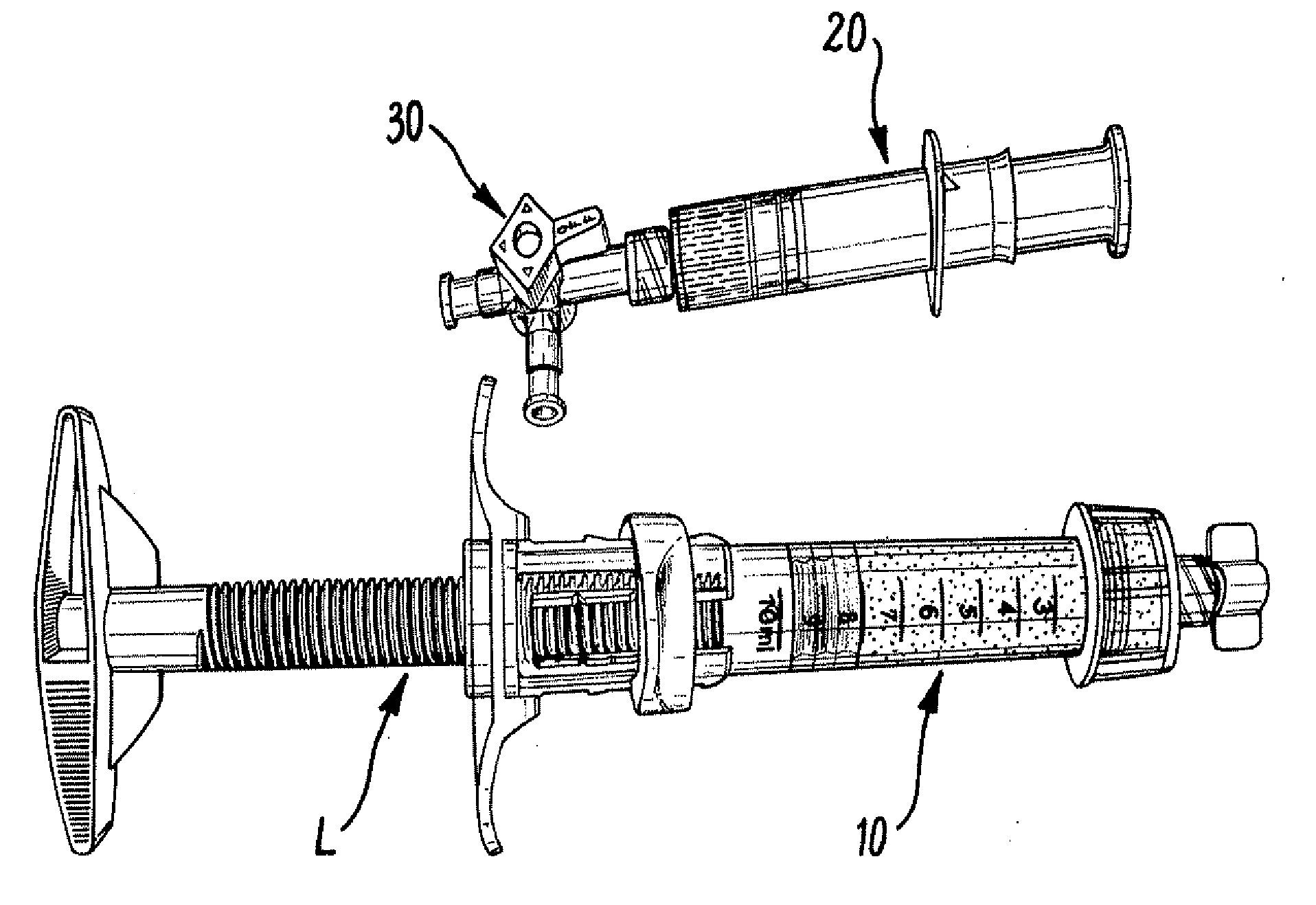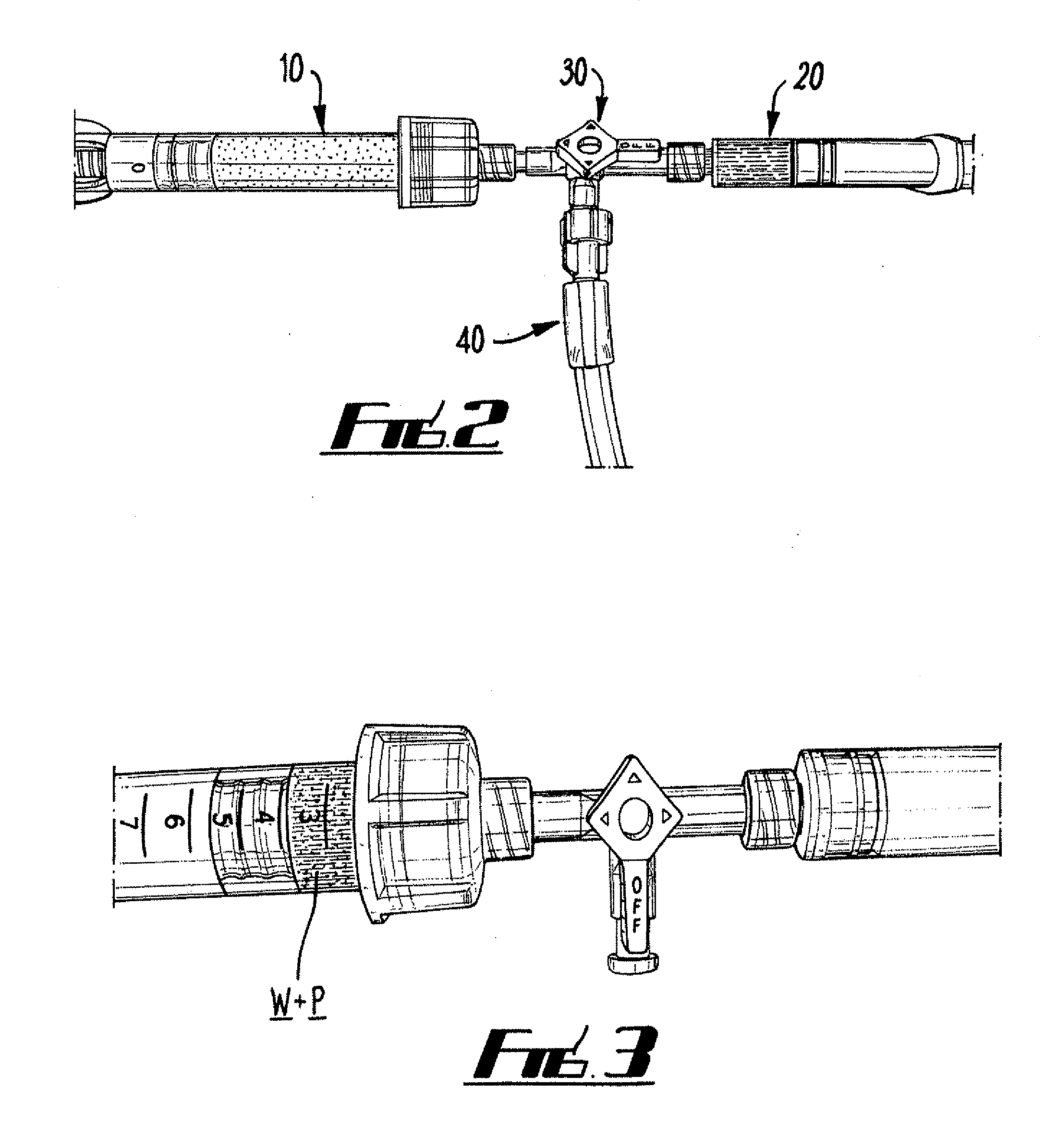Mixing and dispensing apparatus for bone void filler
a technology of mixing apparatus and filler, which is applied in the direction of cement mixing apparatus, mixers, containers, etc., can solve the problems of unsuitable hydraulic setting applications for cementitious pmma materials, the known evacuation system for de-airing cementitious pmma materials is typically unsuitable for hydraulic setting applications, and the expansion of air bubbles in the cohesive paste may remain trapped, etc., to improve x-ray visibility, improve mechanical strength, and increase density
- Summary
- Abstract
- Description
- Claims
- Application Information
AI Technical Summary
Benefits of technology
Problems solved by technology
Method used
Image
Examples
example 1
[0051]Referring to FIGS. 1a and 1b there is shown apparatus for preparing a de-aired hydraulic setting hardenable bone cement (i.e. bone void filler). The apparatus comprises a first and second container and a multi-port connector.
[0052]In this example, five grams of calcium sulphate alpha hemi-hydrate powder, P, having a particle size of substantially less than 150 microns is contained in the first container, which comprises a first piston syringe 10. The first piston syringe 10 has a 10 ml capacity and features a male luer-lock connector 12 and a lockable piston 14 within syringe barrel 16. The first syringe is typically supplied to an end user with an end cap in place over the luer-lock to maintain the contents of the syringe to be free of contamination.
[0053]The second container comprises a second piston syringe 20 and this has a female luer-lock connector 22 and a piston 24 moveable within syringe barrel 26. The syringe 20 has a 5 ml capacity and contains 1.7 ml of water, W.
[00...
example 2
[0063]In a second embodiment of the apparatus and method of the invention, which will now be described in relation to FIG. 4, a variation to the method and apparatus described in the first example is made by pre-combining the second syringe 20 and the three-way connector 30.
[0064]The powder component is supplied in a first syringe 10 in the same way as in the first embodiment. However, by supplying the second syringe 20 pre-connected to the three-way connector 30 with the water component contained both within the syringe 20 and the limb of the three-way connector 30 up-to the three-way valve the quantity of air trapped within the system can be minimised before de-airing.
[0065]In use, the end cap is first removed from the luer-lock end 12 of the powder containing syringe 10 which is then screwed onto the corresponding end of the three way tap in an air-tight manner. The evacuation and mixing procedures are then performed as described in Example 1 with the advantage that there is less...
example 3
[0066]A calcium phosphate powder mixture consisting of equimolar amounts of ground Ca4(PO4)2O (tetracalcium phosphate, TTCP) and CaHPO4 (dicalcium phosphate anhydrous, DCPA) was contained within a lockable piston syringe. The corresponding water component was contained within a simple piston syringe. The powder syringe was initially in the locked position. In use, the two syringes were connected together through a ‘T-piece’ connector and evacuation and mixing of the cement components was undertaken as previously described in Example 1.
PUM
| Property | Measurement | Unit |
|---|---|---|
| vacuum | aaaaa | aaaaa |
| pressure | aaaaa | aaaaa |
| relative pressure | aaaaa | aaaaa |
Abstract
Description
Claims
Application Information
 Login to View More
Login to View More - R&D
- Intellectual Property
- Life Sciences
- Materials
- Tech Scout
- Unparalleled Data Quality
- Higher Quality Content
- 60% Fewer Hallucinations
Browse by: Latest US Patents, China's latest patents, Technical Efficacy Thesaurus, Application Domain, Technology Topic, Popular Technical Reports.
© 2025 PatSnap. All rights reserved.Legal|Privacy policy|Modern Slavery Act Transparency Statement|Sitemap|About US| Contact US: help@patsnap.com



